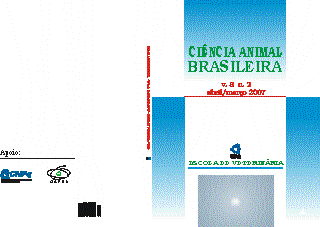IN SITU DEGRADABILITY OF DRY MATTER AND FIBROUS FRACTION SUGARCANE BAGASSE TREATED WITH UREA
Keywords:
Bagaço de cana, Nutrição AnimalAbstract
The experiment was conducted to evaluate the in situ degradability of dry matter (iDMD), neutral detergent fiber (iNDFD), acid detergent fiber (iADFD) and hemicel-lulosis of sugar cane bagasse submitted to ammoniation with urea. The treatments consisted of four urea levels (0%, 2.5%, 5.0% and 7.5% on dry matter – DM basis) added to the sugar cane bagasse and addition of 1.2% (DM basis) of ground soybean as urease source. Samples of 3 g of the bagasses were incubated in the rumen of three steers during periods of 0, 12, 24, 48, 72 and 96 hours. The urea addiction to sugar cane bagasse provided increase not only on the iDMD, but also in degradability of cell wall con-tents. The degradability increased of 73.6, 61.3, 45.6 and 65.7% for DM, NDF, ADF and hemicellulosis, respective-ly, at the longer incubation time (96 hours). The iDMD, iNDFD, iADFD and in situ hemicellusosis degradability of sugar cane bagasse were improved by urea treatment.
KEY-WORDS: Ammoniation, by product, dry matter, cellular wall.
Downloads
Downloads
Published
How to Cite
Issue
Section
License
Copyright (c) 2007 Brazilian Animal Science/ Ciência Animal Brasileira

This work is licensed under a Creative Commons Attribution 4.0 International License.
Authors who publish with this journal agree to the following terms:
- Authors retain copyright and grant the journal right of first publication with the work simultaneously licensed under a Creative Commons Attribution License that allows others to share the work with an acknowledgement of the work's authorship and initial publication in this journal.
- Authors are able to enter into separate, additional contractual arrangements for the non-exclusive distribution of the journal's published version of the work (e.g., post it to an institutional repository or publish it in a book), with an acknowledgement of its initial publication in this journal.
- Authors are permitted and encouraged to post their work online (e.g. in institutional repositories or on their website) prior to and during the submission process, as it can lead to productive exchanges, as well as earlier and greater citation of published work (See The Effect of Open Access).




























